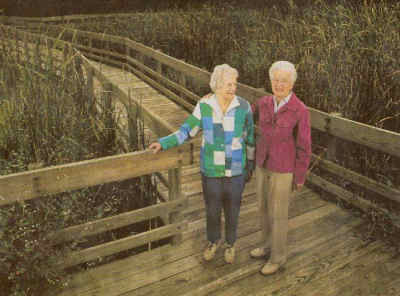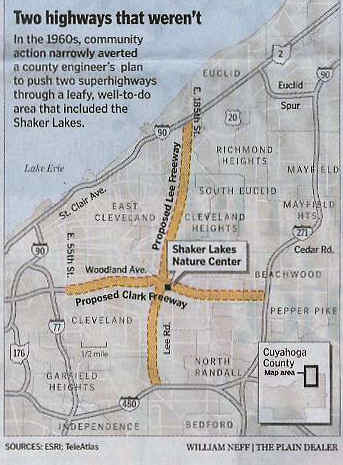
|
Women
saved Shaker Lakes from freeways
Monday, September 25, 2006
Michael O'Malley Plain Dealer Reporter
Catherine
Fuller, who turns 88 next month, still shudders at the idea of a
superhighway cutting through the heart of the Shaker Lakes nature
preserve, destroying 200 acres of wildlife and wiping out hundreds
of nearby homes.
She first got wind of the plan 43 years ago at a garden club meeting
at the North Park Boulevard home of Mary Elizabeth Croxton, just
across the street from the lower Shaker Lake.
"We were horrified," she said. "We immediately said, It's got to be
stopped, no question about it.' "
|
 |
|
Catherine Fuller, 87, and
Kathleen Barber, 82, stand on a deck in the middle of the Shaker
Lakes nature preserve. The two women were on the front lines 40
years ago in a battle to stop two freeways from running through
Shaker Lakes.
photo Joshua Gunter Plain Dealer |
|
|
The
meeting of 11 women was a call to war, pitting ladies' garden clubs
against a powerful, steam-rolling freeway industry and a forceful
county engineer while sowing the seeds of a momentous grass-roots
uprising that drew national media attention.
"It wasn't
hard to mobilize, said Kathleen L. Barber, 82, one of the many
frontline activists in the fight. "People were outraged. When your
home is threatened and your community is threatened, you mobilize."
Fuller and
Barber are founding members of the Shaker Lakes Nature Center, which
celebrates its 40th birthday this month. The center was born in the
heat of the freeway fight and stands today as a monument to victory.
"The whole
East Side should take those ladies out for a couple of cold beers,"
said Tom Bier, an urban studies professor at Cleveland State
University. "Their battle marks one of the most significant bits of
history in the last 50 years because of what didn't happen. They
actually stopped the highway industry, and that's big."
A half
century ago, when America was linking its cities with high-speed
highways, no community was safe from the threat of earthmovers and
concrete trucks, not even the richest community in the nation --
Shaker Heights. The 1960 census showed that Shaker Heights had the
highest median household income in the land, but that had no effect
on the freeway planners.
In October
1963, Cuyahoga County Engineer Albert Porter unveiled the proposed
Clark Freeway, an east-west route linking Cleveland with Pepper
Pike.
It was to run east from East 55th Street near Broadway in Cleveland
to Interstate 271 in Pepper Pike. It would have ripped through the
Shaker Lakes and cut a swath along Shaker Boulevard into Beachwood.
Once the Clark was finished, the plan was to run a north-south
route, called the Lee Freeway, connecting I-90 near Lake Erie to the
Ohio Turnpike. The Clark and the Lee were to intersect where the
Shaker Nature Center is today. |
|
 |
|
"To exchange this park of irreplaceable beauty for a mass of
concrete roadway would be an unthinkable act of vandalism," Croxton
of the Village Garden Club told the New York Times in October 1966.
The two freeways would have taken 1,370 homes and 105 commercial
properties in Cleveland, Cleveland Heights and Shaker Heights,
including the homes of such prominent people as Cleveland Orchestra
conductor George Szell, U.S. Ambassador to Austria Milton Wolf and
Cleveland Mayor Carl Stokes.
They would have also destroyed the final resting place of early
Shaker settler Jacob Russell, a Revolutionary War soldier buried
near Horseshoe Lake.
Croxton and dozens of other garden club ladies, joined by a broad
coalition of residents and environmentalists, launched a massive
campaign led by public officials and prominent residents.
But Porter pushed hard, saying a delay in the project would result
in losing millions of federal highway dollars. He called Shaker
Lakes a "dinky little park and two-bit duck pond" and described the
opposition as a "chintzy, spoiled bunch."
Porter, who was also the county's Democratic Party chairman, was
driving a steamroller that not even Republican Gov. James Rhodes
could stop.
In March 1966, George Condon, a columnist for The Plain Dealer,
wrote, "No doubt the Clark Freeway will go precisely where County
Engineer Porter [says] it will go and the public be damned. But
wouldn't it be nice if ... human values and natural resources took
precedence over the arbitrary plans of the engineers?"
Yes, answered the "chintzy, spoiled bunch," refusing to roll over.
"Better ducks than trucks!" they cried, mounting more public
pressure against Porter and his highway men.
After a seven-year battle, Porter realized he was outgunned. In
1970, buckling to the growing protest, Rhodes quietly took the
freeways off the map.
"We had a wonderful party," Barber said. "I remember a great public
sigh of relief."
Killing the Clark and the Lee also killed tentacles that would have
reached through Highland Heights, Richmond Heights, Gates Mills and
other Cuyahoga County suburbs.
Six years after the battle, The Plain Dealer reported that Porter
had created an employee payroll kickback scheme that raised millions
of dollars for himself.
In November 1976, he was voted out of office. That same year, the
nature center opened a small retail shop called the Duck Pond Gift
Store.
In 1977, Porter was convicted of theft in office. He died in 1979.
© 2006 The Plain Dealer |
|